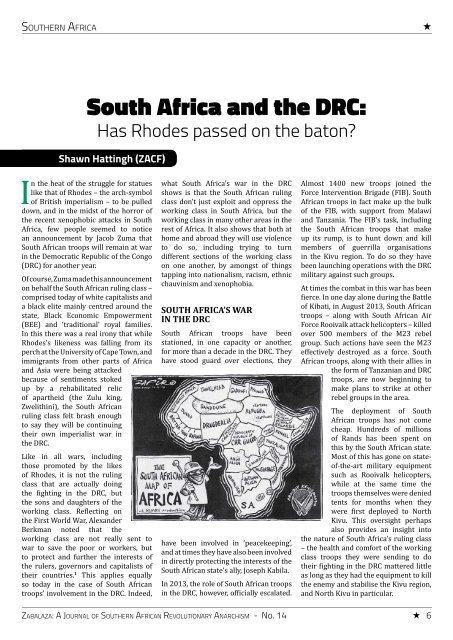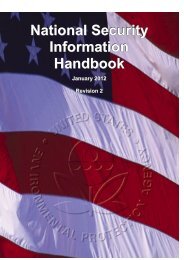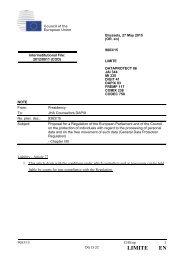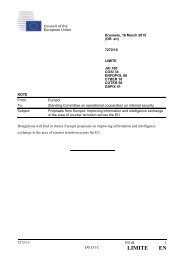SOUTHERN AFRICASouth Africa and the DRC:Has Rhodes passed on the baton?Shawn Hattingh (ZACF)In the heat of the struggle for statueslike that of Rhodes – the arch-symbolof British imperialism – to be pulleddown, and in the midst of the horror ofthe recent xenophobic attacks in SouthAfrica, few people seemed to noticean announcement by Jacob Zuma thatSouth African troops will remain at warin the Democratic Republic of the Congo(DRC) for another year.Of course, Zuma made this announcementon behalf the South African ruling class –comprised today of white capitalists anda black elite mainly centred around thestate, Black Economic Empowerment(BEE) and ‘traditional’ royal families.In this there was a real irony that whileRhodes’s likeness was falling from itsperch at the University of Cape Town, andimmigrants from other parts of Africaand Asia were being attackedbecause of sentiments stokedup by a rehabilitated relicof apartheid (the Zulu king,Zwelithini), the South Africanruling class felt brash enoughto say they will be continuingtheir own imperialist war inthe DRC.Like in all wars, includingthose promoted by the likesof Rhodes, it is not the rulingclass that are actually doingthe ighting in the DRC, butthe sons and daughters of theworking class. Relecting onthe First World War, AlexanderBerkman noted that theworking class are not really sent towar to save the poor or workers, butto protect and further the interests ofthe rulers, governors and capitalists oftheir countries. 1 This applies equallyso today in the case of South Africantroops’ involvement in the DRC. Indeed,what South Africa’s war in the DRCshows is that the South African rulingclass don’t just exploit and oppress theworking class in South Africa, but theworking class in many other areas in therest of Africa. It also shows that both athome and abroad they will use violenceto do so, including trying to turndifferent sections of the working classon one another, by amongst of thingstapping into nationalism, racism, ethnicchauvinism and xenophobia.SOUTH AFRICA’S WARIN THE DRCSouth African troops have beenstationed, in one capacity or another,for more than a decade in the DRC. Theyhave stood guard over elections, theyhave been involved in ‘peacekeeping’,and at times they have also been involvedin directly protecting the interests of theSouth African state’s ally, Joseph Kabila.In 2013, the role of South African troopsin the DRC, however, oficially escalated.Almost 1400 new troops joined theForce Intervention Brigade (FIB). SouthAfrican troops in fact make up the bulkof the FIB, with support from Malawiand Tanzania. The FIB’s task, includingthe South African troops that makeup its rump, is to hunt down and killmembers of guerrilla organisationsin the Kivu region. To do so they havebeen launching operations with the DRCmilitary against such groups.At times the combat in this war has beenierce. In one day alone during the Battleof Kibati, in August 2013, South Africantroops – along with South African AirForce Rooivalk attack helicopters – killedover 500 members of the M23 rebelgroup. Such actions have seen the M23effectively destroyed as a force. SouthAfrican troops, along with their allies inthe form of Tanzanian and DRCtroops, are now beginning tomake plans to strike at otherrebel groups in the area.The deployment of SouthAfrican troops has not comecheap. Hundreds of millionsof Rands has been spent onthis by the South African state.Most of this has gone on stateof-the-artmilitary equipmentsuch as Rooivalk helicopters,while at the same time thetroops themselves were deniedtents for months when theywere irst deployed to NorthKivu. This oversight perhapsalso provides an insight intothe nature of South Africa’s ruling class– the health and comfort of the workingclass troops they were sending to dotheir ighting in the DRC mattered littleas long as they had the equipment to killthe enemy and stabilise the Kivu region,and North Kivu in particular.ZABALAZA: A JOURNAL OF SOUTHERN AFRICAN REVOLUTIONARY ANARCHISM - No. 14 6
One of the saddest parts of this – and there aremany – is that most of the South African troopsare proud of the role that they feel they areplaying in the DRC. In interviews many believethat their mission to the DRC is humanitarian.Some feel they are protecting the local populationfrom guerrilla groups.Certainly these guerrilla groups, like the M23,are no angels. Leaders of the M23 clearly stokeup nationalist sentiments amongst the footsoldiers with the goal of getting their hands onthe resources of North Kivu. War is brutal andbrutalising as theM23 have beenaccused of multipleabuses includingmass rape andmurder. The M23,however, is notthe most brutalgroup in NorthKivu: another rebelgroup that SouthAfrican troops arenow making plansto move against South African troops in the DRCincludes membersthat were allegedly involved in perpetrating thegenocide that took place in Rwanda 21 years ago.Unfortunately the allies of the South Africantroops also do not have clean hands. Generalsfrom the DRC military, alongside whom SouthAfrican troops have been ighting, have also beenaccused of being the architects of war crimes.Likewise, there have been a few incidents inwhich South African troops have been accusedof criminalities in North Kivu, including rape.Indeed, war is a messy business and it almostnever based on humanitarian ideals or onethical considerations: there are usually moreunsavoury reasons behind wars mainly centredaround the political and economic interestsof ruling classes. In the DRC the South Africantroops ighting there are indeed pawns that arebeing used by the South African ruling classand their local allies for their own political andeconomic interests – they are in fact, as will bediscussed later, being used to clear rebel groupsso that sections of the South African ruling classcan take advantage of mineral and oil concessionthat they own in North Kivu. In the process,working class soldiers are being brutalised andturned into killers.WHAT ARE THE INTERESTS OF THESOUTH AFRICAN RULING CLASS INTHE DRC?The South African ruling class view the DRCas a strategic country that has the potentialto produce vast proits not only for privatelyowned South African companies, but also stateowned ones. Already there are many SouthAfrican linked companies that have interestsin and/or have invested in the DRC, includingMTN, Barloworld, Nandos, Shoprite, AECI,African Rainbow Minerals, Famous Brands,Aveng, Standard Bank, Group Five, Metorex, PPCCement, Raubex, Grindrod, and Super Group. Aspart of these operations, South African linkedcompanies are not only involved in extracting theDRC’s natural resources, but also exploiting theDRC’s workingclass as a sourceof cheap labourand a market fortheir goods.Over and aboveprivate interestsin the DRC, theSouth Africanstate too hase c o n o m i cand strategicinterests in theDRC. The stateowned oil andgas company, PetroSA, has operations in the DRC.The South African state too views the Congo Riveras a potential source of electricity that could atone stroke deal with the short fall of electricitythat South Africa is facing. As part of this, andfor or over a decade, the South African statealong with the state owned electricity company,Eskom, have been negotiating with the DRC stateto build a series of hydro-electric dams on theCongo River that would supply South Africanindustry with up to 40 000 MW of electricity aday. In 2013 a treaty was inally signed betweenthe two states to concretely go ahead with theproject and immediately the South African stateput aside R 200 billion for the project.THE EMBRACE OF IMPERIALISTS ANDTHE LOCAL RULING CLASSDue to the fact that the South African ruling classviews the DRC as so strategic it has used variousmeans to try and get a foothold in the country,and subsequently expand that foothold. Indoing so the South African ruling class has beencompeting with other imperialist powers such asthe United States, Britain, Canada and China.The South African ruling class’s initial attemptsto get a foothold into the DRC were linked to itsbid to bring about peace talks between warringparties in the late 1990s and early 2000s. Theaim of this was to try and bring adversariestogether to end the conlict so that a stableenvironment could be achieved for investors.SOUTHERN AFRICA[T]he SouthAfrican rulingclass viewsthe DRC asso strategicit has usedvarious meansto try and geta foothold inthe country,and ... expandthat foothold.In doing sot[they have]been competingwith otherimperialistpowers suchas the UnitedStates, Britain,Canada andChina7 ZABALAZA: A JOURNAL OF SOUTHERN AFRICAN REVOLUTIONARY ANARCHISM - No. 14







